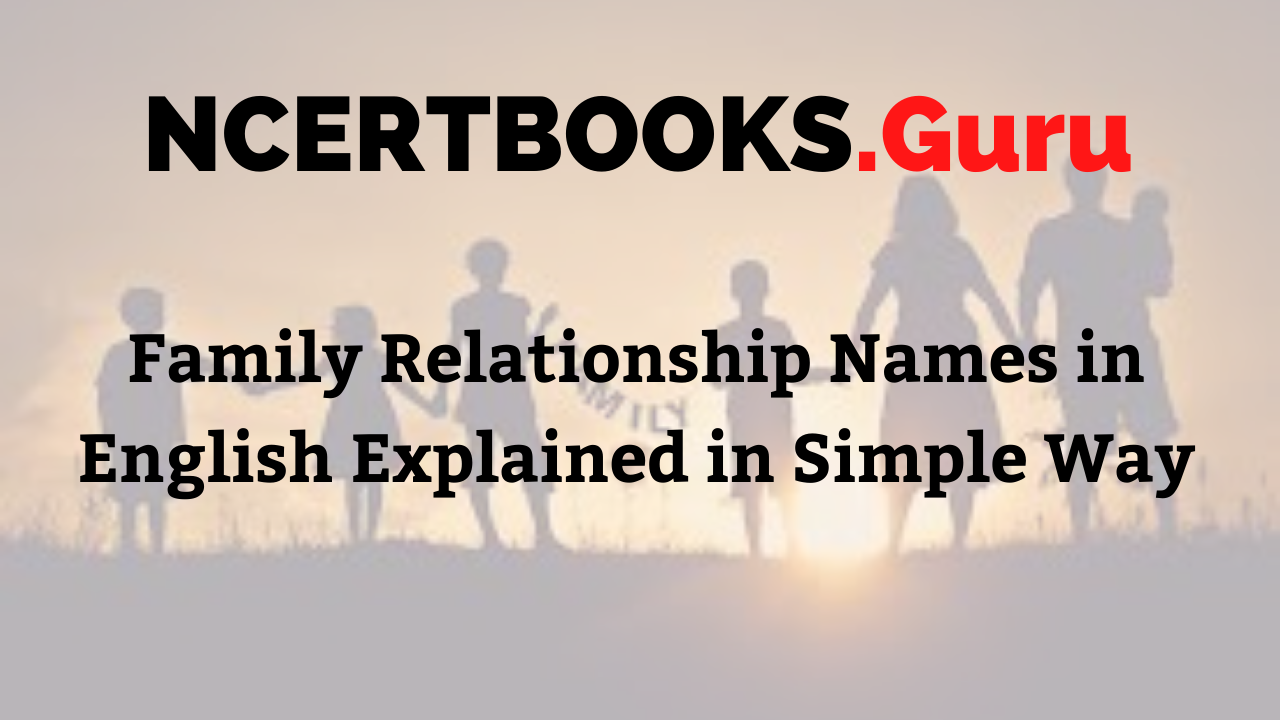Your family members are also your relatives. You can have an immediate or nuclear family and an extended family. Your immediate family includes your parents and siblings, while your extended family includes all of the people in your father’s and mother’s families.
Gather Information Regarding Basic English Skills and become proficient in the language and speak fluently with confidence. Try the Tips over here and Improve your English Writing and Speaking Skills.
Family Relationship Names in English
1. Immediate family
Family refers to a person’s smallest family unit, consisting of the closest relatives such as parents, siblings, and children. The inclusion of the immediate family members may differ depending on which organization determination. Your immediate family may include:
Father: The male parent.
Mother: The female parent.
Daughter: The female child of the family.
Son: It is the male child of the family.
When a pair gets married, the man is the husband, and the lady is the wife. The family’s male sibling is the brother, while the family’s female sibling is the sister.
2. The Stepfamily
A Stepfamily, a bonus family and a blended family are families where at least one parent has children that are not biologically or adoptive related to the other spouse or partner. Children in the stepfamily may live with one biological or adoptive parent. The stepfamily also falls under the category of an immediate family.
” Step-” means that you are related as a result of one parent marrying again. This is the term used to describe the new members of the family when someone gets married. Therefore, Immediate families can also include:
Half-siblings: A half-brother or half-sister shares one parent with each other. They may have the same father but different mothers, or the same mother but different fathers.
Stepsiblings: A stepbrother or stepsister share one common parent who is married to each other at that point.
Stepparents: A Stepmother or Stepfather is not biologically one’s parent but is married to one of the biological parents.
Stepchildren: A stepson or stepdaughter is not biologically one’s child. Instead, they are the children of the person someone is married to at a particular time.
Even if your parents didn’t get married or had the child outside of marriage, they are still your half-brother or half-sister. However, it is prevalent to refer to your half-brother or half-sister as merely brothers and sisters.
A stepparent is the spouse of someone’s parent and not their biological or adoptive parent. A step-grandparents is also not someone’s biological grandparents, the step-grandfather is the male one, and the step-grandmother being the female one.
A step-aunt is the spouse of your parent’s brother or sister and is not the mother of your cousin. There is no blood relation in this relationship.

3. The maternal family relationship
The definition of maternal is something related to the characteristics of a mother like relatives from a mother’s side of the family. They include:
Maternal aunt: The sister of your mother is your maternal aunt. The word is also used to refer to your maternal uncle’s spouse.
Maternal uncle: The brother of your mother is your maternal uncle. This word is also applied to refer to your maternal aunt’s spouse.
Maternal grandmother: The mother of your mother.
Maternal grandfather: The father of your mother.
4. The paternal family relationship
The side of your family, which is related to your father, is known as the paternal family. They include:
Paternal aunt: The sister of your father is your paternal aunt. This word is also applied to refer to your paternal uncle’s spouse.
Paternal uncle: The brother of your father is your paternal uncle. This word is also applied to refer to your paternal sister’s husband.
Paternal grandmother: The mother of your father.
Paternal grandfather: The father of your father.
5. Second-degree relatives
Your paternal side and maternal side of the family is also your second degree or extended family. A second-degree relative is someone who shares a quarter of a person’s genes. They are a part of your extended family and the closest to you after your immediate family. Other than your grandparents or uncle and aunt, they also include:
Grandson: The son of your daughter or son is your grandson.
Granddaughter: The daughter of your daughter or son is your granddaughter.
Double cousin: Cousins with twice the number of common ancestors are known as double cousins. You and your double cousin share about a quarter of your genes, which is the same amount you share with your grandparent, a half-sibling, an uncle, or aunt.
6. Third-degree relatives
Third-degree relatives are a category of family members that constitutes a segment of the extended family. The expression is generally used in reference to the amount of genetic overlap that exists between the two sets of people, with third-degree relatives sharing approximately one-eighth of their genes. They may include:
Great-grandparents: The parents of your grandparents.
Great-grandchildren: The children of your grandchildren.
Great-uncle: The uncle of your mother or father
Great-aunt: The aunt of your mother or father
Half uncle: The half-brother of your parent.
Half-aunt: The half-sister of your parent.
Half-niece: The daughter of your half-sibling.
Half-nephew: The son of your half-sibling.
7. The in-laws of the family
The in-laws are the members of the family of your spouse or any other marriage in your family. This relationship indicates that it is bounded by marriage and not by blood.
The father of your spouse or partner is your father-in-law.
The mother of your spouse or partner is your mother-in-law.
The husband of your daughter is your son-in-law.
The wife of your son is your daughter-in-law.
Your sister’s married husband is your brother-in-law.
Your brother’s married wife is your sister-in-law.
The term aunt-in-law refers to the wife of one’s uncle or the aunt of one’s spouse. Uncle-in-law is the husband of one’s aunt or the uncle of one’s spouse. These terms are essentially used to refer to two different relationships interchangeably.
In Indian English, a sibling-in-law who is the spouse of your sibling can be referred to as the co-sibling, precisely co-sister or co-brother.
8. Relation in the family of your siblings
A nephew or niece is the child of one’s sibling or sibling-in-law. As aunt or uncle are separated from the niece or nephew the two generations, they are examples of second-degree relation and quarterly related to you.
Niece: The daughter of your sister or brother, or your brother in law or sister in law.
Nephew: The son of your sister or brother, or your sister in law or brother in law.
A fraternal relative is one who is related to the sister or brother. The in-laws share the in-law relationships of the spouse’s relatives. These can include:
A niece-in-law or nephew-in-law: The spouse of your niece or nephew or the niece or nephew of your spouse.
It is common in some cultures and family traditions to refer to your half-niece or half-nephew as just niece or nephew.
9. The Cousin relation
What is a cousin?
Cousins are people who share a mutual ancestor that is at least two generations away, such as a grandparent or great grandparents. You and your siblings are not considered cousins because your parents are only one generation away from you.
The number linked with your cousin has to do with how many generations away your common ancestor is. For example:
If you and another person share a grandparent who is two generations away, that person is your first cousin. In simple words, first cousins are the children of your uncle or aunt.
If you share a great-grandparent who is three generations away, then that person is your second cousin.
If you share a great-great-grandparent who is four generations away, then that person is your third cousin.
If you share a grandparent who is five generations away, then that person is your fourth cousin.
Sometimes you may share a mutual ancestor with your cousin, but you each call this ancestor something different. The common ancestor could be your great-grandparent, but your cousin’s great-great-grandparent.
Step-cousins are stepchildren of an individual aunt or uncle, nieces and nephews of one stepparent, or the children of someone’s parents step sibling. Cousin-in-law is the cousin of a person’s spouse or the spouse of a person’s cousin. None of these relationships have consanguinity and therefore are not related by blood.
10. The once removed family
Degrees and removals are used to more precisely describe the relationship between cousins. To be ‘once removed’ from a cousin means you are separated by one generation. The number before removed will represent the number of generations you are separated from the cousin. For example :
Cousin once removed: A cousin who is either one generation above or below you.
Cousin twice removed: A cousin who is separated from you by two generations.
This pattern continues with each generation, and they are known as distant cousins.
Interestingly according to sources, Vogue singer Madonna is Hillary Clinton’s 10th cousin. Clinton is also related to Angelina Jolie from the other side of her family, and they are night cousins twice removed.
There is another far stretched but exciting relationship. Through ancestral tracing, it was also found out that American comedian Ellen DeGeneres and the English princess Kate Middleton are 14th cousins twice removed.
